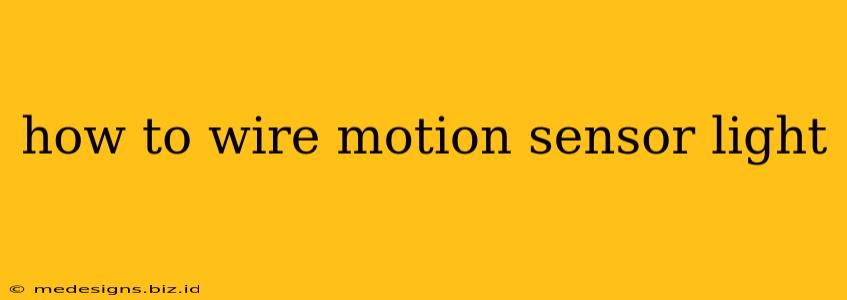Installing a motion sensor light can significantly improve your home's security and energy efficiency. But before you start, it's crucial to understand the wiring process. This guide provides a comprehensive walkthrough, covering various wiring scenarios and troubleshooting tips. Remember, safety is paramount. If you're uncomfortable working with electricity, consult a qualified electrician.
Understanding Your Wiring
Before you begin, turn off the power to the circuit at the breaker box. This is the most important safety precaution. Next, you need to identify your existing wiring. Common wire colors include:
- Black (Hot): Carries the electrical power to the light.
- White (Neutral): Returns the power to the circuit.
- Green or Bare Copper (Ground): Provides a safety path for electricity.
Your motion sensor light will also have corresponding wires. These are usually clearly marked, but if not, consult your light's instruction manual.
Types of Motion Sensor Light Installations
There are several ways to wire a motion sensor light, depending on your existing setup:
1. Replacing an Existing Light Fixture
This is the simplest scenario. You'll simply be replacing your old light fixture with a motion sensor light.
- Disconnect the wires: Carefully disconnect the wires from your old fixture, taking note of their connections. Use a wire stripper and possibly pliers to aid in disconnecting.
- Connect the new wires: Connect the wires from your motion sensor light to the corresponding wires in your junction box, matching colors. Use wire nuts to secure the connections. Ensure all connections are tight to prevent loose wires.
- Mount the fixture: Secure the motion sensor light to the junction box.
- Test the light: Turn the power back on at the breaker box and test the functionality of the motion sensor light.
2. Installing a New Motion Sensor Light Circuit
This involves running new wiring from your breaker box to the desired location. This is a more complex task that requires a good understanding of electrical work and may not be suitable for DIY beginners. It's highly recommended to hire a professional electrician for this.
3. Wiring a Motion Sensor Light to an Existing Switch
This allows you to control the light both automatically (via the motion sensor) and manually (via the switch). This usually requires a three-way switch setup.
- Identify the wires: At the switch box, you'll usually find three or more wires: a black (hot), white (neutral), and possibly a red or black traveler wire and ground wire.
- Wiring the motion sensor light: Connect the motion sensor light's wires according to the instructions provided with the specific model. You'll need to carefully determine where to connect the wires to work with the three-way switch setup. Consult a wiring diagram for a three-way switch if needed.
- Test the light: Once all connections are made, turn the power back on and test both the automatic and manual operation of the light.
Troubleshooting Common Issues
- Light doesn't turn on: Double-check all wire connections, ensuring they are tight and secure. Verify that the power is on at the breaker box. Check the breaker itself for any tripped breakers.
- Sensor doesn't detect motion: Make sure the sensor is properly aimed and not obstructed by anything. Adjust sensitivity settings if available. Also check the power supply and if the sensor is defective.
- Light flickers: This often indicates a loose wire connection. Recheck all connections. A flickering light might also indicate a short circuit - turn off the power immediately and seek a qualified electrician.
Choosing the Right Motion Sensor Light
Consider these factors when selecting a motion sensor light:
- Range of detection: How far away does it need to detect motion?
- Light output: What brightness and type of bulb (LED, incandescent, etc.) do you need?
- Mounting options: Does it need to be wall-mounted, ceiling-mounted, or both?
- Features: Some offer adjustable sensitivity, timer settings, and more.
By following these steps and paying attention to safety, you can successfully wire your motion sensor light and enjoy the benefits of improved security and energy savings. Remember, if you are uncertain about any aspect of the installation, call a qualified electrician. Your safety should always be the top priority.
